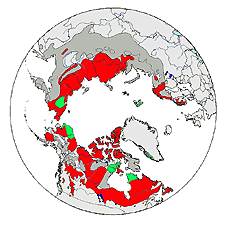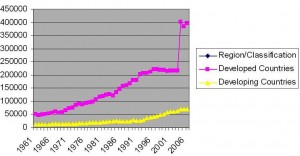- DFID-supported collection of stories showing how information about new ways of doing things is communicated to rural people in developing countries includes some agrobiodiversity stuff.
- The genetic nature of the Pea-comb phenotype in chickens.
- Entomopathogenic fungus can become an endophyte in sorghum and confer protection from stem borer. Ain’t agrobiodiversity grand?
- Different earthworm species have different effects on the competition between four annual plants and their relative fecundity. Ain’t agrobiodiversity grand?
Reindeer game up
The species Rangifer tarandus is divided into seven subspecies, but all are in trouble, according to a survey of their status published in a recent paper in Global Change Biology. We’re talking about the animals that are usually called reindeer in Europe and caribou in North America. All across their circum-polar range their populations are undergoing an unprecedented synchronous decline (red denotes herds in decline in the map below, which I hacked from the BBC article quoted below, green indicates those on the increase and dark grey means no data is available).

One subspecies — R. t. tarandus — comprises the semi-domestic and wild reindeer that live across northern Scandinavia and Russia and are so important to the Sami people and others. Here’s one of the authors quoted by the BBC on the causes of the decline:
“If global climate change and industrial development continue at the current pace, caribou and reindeer populations will continue to decline in abundance,” says Vors.
“Currently, climate change is most important for Arctic caribou and reindeer, while anthropogenic landscape change is most important for non-migratory woodland caribou.”
Interestingly, reindeer were recently re-introduced to Britain after a gap of 800 years. I guess their long-term future there must be in question.
Database hell squared beckons?
Colleagues at FAO and Bioversity International have a paper out in the Journal of Food Composition and Analysis entitled “Food composition is fundamental to the cross-cutting initiative on biodiversity for food and nutrition.” The cross-cutting initiative in question is that on biodiversity for food and nutrition which the CBD asked FAO to lead, in collaboration with Bioversity. And by the “food composition” of the title the authors mean databases which document the nutritional value of foods not just at the level of species, as currently, but of the different varieties and cultivars within species. These will in a way be a central pillar of the initiative. We’ve talked here before about the extensive variation that can exist among varieties in nutritional composition, for glycaemic index, say. And we’ve repeatedly highlighted the work of Lois Englberger and her Pohnpei colleagues in this field, for example. So it is good to hear that food composition tables and databases will be improved to allow the inclusion of infra-specific data. Populating the databases will be something else, of course. The data will need to come from existing genetic resources databases, which currently do not as a rule contain much in the way of this kind of information and are not necessarily equipped to handle it. So this initiative will involve a marriage between two database communities, that of nutritionists and that of genebanks. A difficult trick to pull off. Necessary, and long overdue, but difficult. Stay tuned.
Talking turkey data
So I was playing around with the agriculture data on WRI’s EarthTrends the other day. Actually it’s mainly — though not entirely — data from FAOStat, and there are the usual provisos about the methodology. 1 But look at what has been happening to turkey numbers in developed countries lately.
Numbers doubled between 2003 and 2004! Is that real? If so, what’s been driving the trend?
DIVERSEEDS puts out DVD
DIVERSEEDS is a scientific project supported fully by the European Commission´s 6th framework programme. We are “Networking on conservation and use of plant genetic resources in Europe and Asia.”
And I think we may have mentioned them before. Anyway, the latest news from the network is that they have a DVD out:
This documentary shows why biodiversity is important for agriculture and how it is conserved and used in many different locations in Europe and Asia.
The DVD costs about US$40, but you can get a discount if you order five or more. I haven’t seen it, so I can’t tell you much more about it. But the contents seems to consist of a series of fifteen or so short (average 3 minutes) films on a wide variety of agrobiodiversity conservation and use initiatives, ranging from the Austrian NGO Arche Noah, to the Thai genebank, to crop wild relatives in the Fertile Crescent, to the Svalbard Global Seed Vault. I’ll try to get hold of a copy and report.
